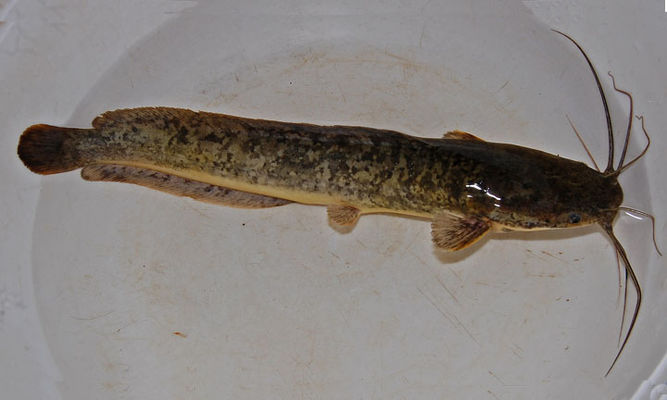Scientific Name: Clarias gariepinus (Burchell, 1822)
English Name: North African catfish
Local/Bangla Name: Not Known
Classification:
Kingdom: Animalia
Phylum: Chordata
Class: Teleostei
Order: Siluriformes
Family: Clariidae
Description:
Dorsal spines (total): 0; Dorsal soft rays (total): 61-80; Anal spines: 0; Anal soft rays: 45 – 65; Vertebrae: 56 – 63. Diagnosis: body depth 6-8 times in standard length, head 3-3,5 times in SL (Ref. 34290) or 30-37% SL (Ref. 28714). Head somewhat between rectangular and pointed in dorsal outline; snout broadly rounded; eyes supero-lateral and relatively small (Ref. 248). Teeth on premaxilla and lower jaw small, fine and arranged in several rows; nasal barbels 1/5-1/2 times as long as head in fishes longer than 12 cm, and 1/2-4/5 of head length in smaller individuals; maxillary barbels rarely shorter than head, usually somewhat longer and reaching to a point midway between origin of dorsal fin and insertion of pelvic fins; outer mandibular barbel longer than inner pair (Ref. 34290). Postorbital bones in contact; lower part of head with 2 black, lateral bands (Ref. 81644). Contrary to other Clarias species, Clarias gariepinus has a high number of gill rakers varying from 24-110 (Ref. 248, 34290, 81644, 101841), the number increasing with size of the fish; gill rakers long, slender and closely set (Ref. 248, 34290). Distance between occipital process and base of dorsal fin is short; dorsal fin almost reaches caudal fin; anal fin origin closer to caudal fin base than to snout, nearly reaching caudal fin (Ref. 248). Pelvic fin closer to snout than to caudal fin base (Ref. 248) or about midway (Ref. 28714). Pectoral fin extends from operculum to below 1st dorsal fin rays (Ref. 248). Pectoral spine robust (Ref. 248), serrated only on its outer face (Ref. 248, 81644), the number of serrations increasing with age (Ref. 248). Lateral line appears as a small, white line from posterior end of head to middle of caudal fin base; openings to secondary sensory canals clearly marked
Habitat & Distribution in Bangladesh:
Occur mainly in quiet waters, rivers and lakes, pools, irrigation and sewage effluent canals.
Environment:
Freshwater (Benthopelagic)
Comments:
Exotic fish in Bangladesh. It hasbeen introduced from Thailand (1990) for aquacultural purposes.
References:
Siddiqui KU, Islam MA, Kabir SMH, Ahmad M, Ahmed ATA, Rahman AKA 2005 Freshwater Fishes of Bangladesh, 2nd ed., Zool. Soc. Bangladesh, Dhaka, Bangladesh, xviii + 394 pp. AKA, Haque EU, Ahmed ZU, Begum ZNT, Hassan MA, Khondker M, Rahman AKA 2005 Freshwater Fishes of Bangladesh, 2nd ed., Zool. Soc. Bangladesh, Dhaka, Bangladesh, xviii + 394 pp. MM (eds.) 2007 Encyclopedia of Flora and Fauna of Bangladesh, Vol. 23. Freshwater Fishes. Asiatic Society of Bangladesh, Dhaka 300 pp.








